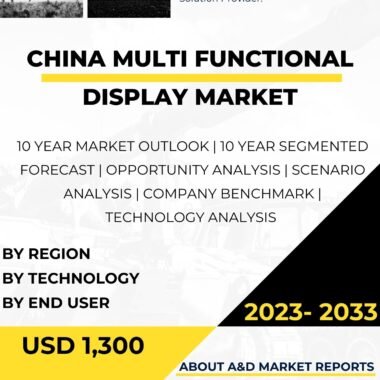Description
The Multi-Function Display (MFD) market in the United States is a dynamic and rapidly evolving sector that plays a crucial role in various industries, particularly aviation, defense, and transportation. MFDs are versatile and advanced display systems that consolidate multiple data sources into a single screen, providing users with comprehensive and intuitive information at their fingertips. As technology continues to advance, MFDs are becoming increasingly sophisticated, offering enhanced capabilities, improved user interfaces, and seamless integration with other systems.
In the aviation industry, MFDs are a key component of modern cockpit displays. They have replaced traditional analog gauges and indicators, streamlining information for pilots and enhancing situational awareness. MFDs consolidate critical flight data, navigation information, engine parameters, weather updates, and other essential data, enabling pilots to make informed decisions quickly and effectively.
One of the notable trends in the aviation MFD market is the transition from cathode ray tube (CRT) displays to liquid crystal displays (LCDs) and organic light-emitting diode (OLED) technologies. LCD and OLED MFDs offer higher resolutions, better contrast ratios, and improved color representation, providing pilots with clearer and more precise information.
Furthermore, aviation MFDs are increasingly adopting touch-screen interfaces, which simplify interactions and reduce the need for excessive button pressing. The integration of touch-screen technology in MFDs enhances the user experience and reduces cognitive workload for pilots, contributing to enhanced safety and operational efficiency.
Beyond commercial aviation, MFDs also play a pivotal role in the defense sector. Military aircraft and ground vehicles are equipped with advanced MFDs that offer real-time tactical data, threat assessments, mission planning information, and sensor feeds. These MFDs empower military personnel with critical information during combat operations, enabling them to respond swiftly to changing situations.
The defense MFD market is witnessing a growing demand for open architecture displays that can integrate with a wide range of systems and sensors. Open architecture MFDs enable seamless integration and data sharing between various platforms, enhancing interoperability and enabling joint operations between different military branches and coalition forces.
Moreover, the defense MFD market is seeing an increased focus on ruggedization and resistance to harsh environmental conditions. Military operations often take place in challenging terrains and extreme climates, and MFDs need to withstand severe vibrations, temperature fluctuations, and electromagnetic interference.
In addition to aviation and defense, MFDs are also transforming other sectors, such as transportation and marine applications. In the transportation industry, MFDs are revolutionizing vehicle dashboards, providing drivers with critical information about vehicle performance, navigation, and safety systems. Additionally, MFDs in public transport systems offer passengers real-time travel information, entertainment options, and safety instructions.
In marine applications, MFDs are becoming essential tools for navigational purposes. Marine MFDs consolidate electronic charts, radar data, sonar information, weather updates, and other maritime data, providing captains and crew with comprehensive information for safe and efficient navigation.
The growth of the MFD market is fueled by various technological advancements, including the integration of augmented reality (AR) and virtual reality (VR) capabilities. AR and VR MFDs offer enhanced visualization of data, enabling users to overlay virtual elements onto the real-world environment. These technologies have the potential to revolutionize training, mission planning, and decision-making processes across different industries.
Furthermore, the increasing demand for compact and lightweight MFDs is driving innovation in display technologies and materials. Portable MFDs with high-resolution displays are particularly sought after in tactical and mobile applications, enabling users to access critical information on the move.
Additionally, the MFD market is witnessing a shift towards more energy-efficient displays and components. The drive for energy efficiency aligns with the growing emphasis on sustainability and reduced environmental impact. Energy-efficient MFDs contribute to longer battery life, lower power consumption, and overall cost savings.
As the MFD market continues to expand, it faces certain challenges. One such challenge is data overload, especially in complex and information-rich environments. Designing MFDs with intuitive user interfaces that prioritize essential information and minimize distractions is crucial to address this issue effectively.
Another challenge is cybersecurity. As MFDs become more connected and integrated with other systems, they become potential targets for cyberattacks. Ensuring robust cybersecurity measures, such as encryption and intrusion detection, is essential to safeguard critical data and maintain the integrity of MFD operations.
In conclusion, the Multi-Function Display market in the United States is experiencing rapid growth and innovation, driven by advancements in technology and the increasing demand for enhanced situational awareness and data integration. MFDs have become integral components in aviation, defense, transportation, and marine applications, providing users with comprehensive and intuitive information displays.
The evolution of MFDs, from CRT-based systems to advanced touch-screen displays and open architecture designs, reflects the ongoing commitment to improving user experience, operational efficiency, and safety. As new technologies, such as AR and VR, continue to emerge, the MFD market is poised to witness further transformation, enhancing decision-making processes, training capabilities, and overall mission effectiveness across various industries.
However, addressing challenges related to data overload, cybersecurity, and environmental sustainability is essential to ensure the continued success and development of the MFD market. As technology evolves and user needs evolve, the United States remains at the forefront of MFD innovation, shaping the future of this critical display technology in an increasingly connected and data-driven world.




